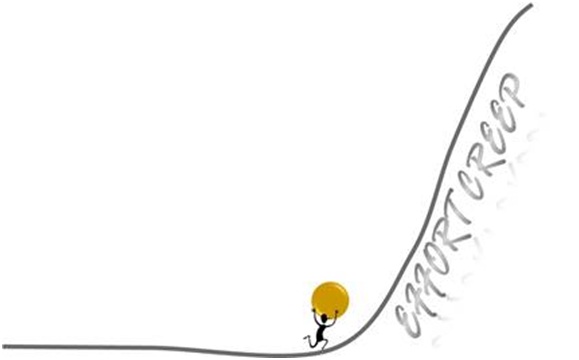Effort Creep
“We thought it would take a week, but …”

We often experience hope creep together with effort creep. Lack of communication about any creep is a major issue, because we cannot manage what we do not know about. Hope creep is a topic of my previous post, and I will assume we know how to mitigate it. If we find out about effort creep early, we can choose an appropriate problem-solving technique to manage it.
Why does effort creep happen?
In my view, the key reasons for effort creep range from faulty design solution, to lack of skills or overly optimistic estimates. Sometimes our own brain is a culprit. I am sure you can recall having a mental block that prevented you from finding a solution that seemed to be so close…
What should we do if we experience effort creep?
Unfortunately, effort creep often means that we need to start again. Reviewing the problem and assessing alternative solutions might help us identify the reason for the creep and point to a better solution. From a project perspective, this calls for rework, using contingency funding and time extension, but it is better done earlier than later. In the end, this is what contingency is there for.
If we can’t find a better solution and think the problem is in the team members’ skills or overly optimistic duration estimates, then we often rush to add more resources to the task. If it takes one person two weeks to do the work, then two people should be able to do it in a week, right?
Brook’s law
It depends. Some tasks do respond to such strategy. In project management, we call such activities “partitionable”. They are usually tasks that can be easily divided between workers so that each worker could continue to perform independently from others. Bricklaying or tiling may be good examples (though we still need to consider the interaction between workers when they join their separate pieces of work).
Unfortunately, effort creep is most prevalent in non-partitionable tasks. Adding more manpower to such tasks will not speed them up. Even worse, it will often slow them down or even stop their progress altogether, at least for a while. Think about John, a software engineer, who is struggling to complete a software module. He is working hard, but not making progress. The project is now running late. Will the job finish quicker if we add Mike, a highly skilled engineer, to the task?
Unfortunately, Brook’s Law states that in such situation we will probably experience further delay. Instead of persevering on his task, John will now need to spend time explaining the problem to Mike. The more unique and complex the task and the further John progressed in solving it, the longer the delay. Sometimes we are better off just letting John do it.
Teddy bear effect
There is however one important aspect of adding Mike to the picture. He may not be able to speed up the task by his own effort, but he may help even if he is not particularly knowledgeable in the subject. Mike’s presence requires John to describe the problem. The very effort of describing and putting it into words for a listener tends to help bring up new perspectives in the speaker’s mind, often triggering a “Eureka!” moment. Mysteriously, this seems to work even we talk to a passive or uninformed listener. Some managers even call it a “teddy bear effect”, comparing a listener to a stuffed animal who without saying a word encourages the speaker to frame the problem in simple terms and in the process articulate the answer!
Personally, I have not really tried to describe my problems to a teddy bear yet, but having someone to talk to helped me many times, notwithstanding whether my listener had anything to add to my own knowledge of the problem.
Problem solving and decision making techniques
There are many other problem solving techniques that help address effort creep, but they are a separate topic for discussion. I have included a comprehensive overview in my Influencing and Making Decisions subject in an MBA course and am currently working on development of a short executive program that would focus on critical thinking and business problem solving.

